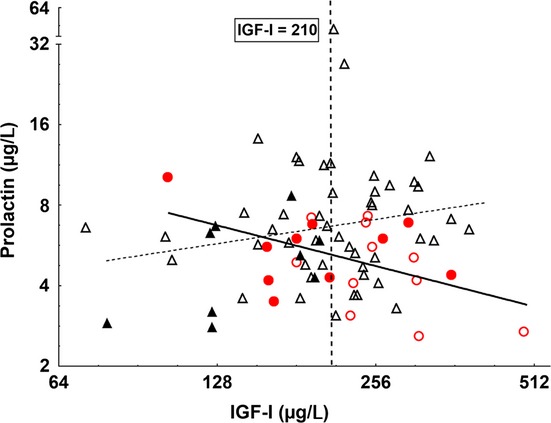Figure 1.

Correlation between insulin-like growth factor-1 (IGF-I) and prolactin levels in the different groups. Symbols represent preterm children with (•) or without (o) behavioural/eating disorders and term- small for gestational age (SGA) and controls (full-term group) with ( ) or without (
) or without ( ) behavioural or eating disorders. IGF-1 was inversely correlated with prolactin in the preterm group (solid line; r = −0.38, p = 0.046); in contrast, the combined term-SGA and controls showed a positive correlation (dashed line; r = 0.23, p < 0.1). The mean IGF-I in the entire cohort was 207 μg/L. When the rounded-off mean value (210 μg/L) was used as a threshold value, it was clear that preterm children with IGF-1 levels below 210 μg/L had a significantly higher incidence (p < 0.05) of behavioural/and or eating disorders than those with IGF-1 levels above the threshold (Pearson's χ2 test).
) behavioural or eating disorders. IGF-1 was inversely correlated with prolactin in the preterm group (solid line; r = −0.38, p = 0.046); in contrast, the combined term-SGA and controls showed a positive correlation (dashed line; r = 0.23, p < 0.1). The mean IGF-I in the entire cohort was 207 μg/L. When the rounded-off mean value (210 μg/L) was used as a threshold value, it was clear that preterm children with IGF-1 levels below 210 μg/L had a significantly higher incidence (p < 0.05) of behavioural/and or eating disorders than those with IGF-1 levels above the threshold (Pearson's χ2 test).
